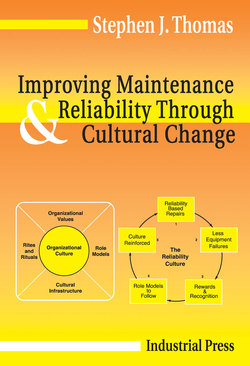Читать книгу Improving Maintenance and Reliability Through Cultural Change - Stephen Thomas G. - Страница 5
На сайте Литреса книга снята с продажи.
ОглавлениеTable of Contents
Cover
Title Page
Copyright
Dedication
Foreword
Acknowledgements
Chapter 1 The Beginning
1.1Introduction
1.2Why I Wrote This Book
1.3Who Can Benefit
1.4Why Is This Book Different?
1.5What Is included?
1.6Navigating Through The Book
1.7Getting Started
Chapter 2 Culture Defined
2.1What Is Organizational Culture Anyway?
2.2Culture Defined
2.3Why Is This Definition Important?
2.4Types of Organizational Culture
2.5The Elements of Culture
2.6Sub-Cultures
2.7The Eight Elements of Change
Chapter 3 Vision and the Goal Achievement Model
3.1The Need for Vision and Goals
3.2What Is Vision?
3.3Why Is a Vision Required?
3.4The Goal Achievement Model
3.5How the Goal Achievement Model Works
3.6A Reliability – Based Example
3.7Goal Achievement Model Measures
3.8Final Thoughts
Chapter 4 Organizational Values
4.1An Introduction to Organizational Values
4.2What Are Organizational Values?
4.3Written vs. Actual Values
4.4Values Gone Astray
4.5Vision and Values
4.6When Values Are Out of Alignment with the Vision (Quadrant 3)
4.7New Values and an Old Vision (Quadrant 2)
4.8How to Change
4.9Success Looks Like
Chapter 5 Role Models
5.1What Is a Role Model?
5.2Role Models Defined
5.3Strategic or Tactical Alignment
5.4Cultural Alignment
5.5Bad Role Models Have Value
5.6Role Models Are Created NOT Born
5.7How Role Models Can Change a Culture
5.8Can Consultants Be Role Models?
Chapter 6 Rites and Rituals
6.1Introduction to Rites and Rituals
6.2What Is a Ritual?
6.3What Is a Rite?
6.4How Rites and Rituals Are Tied Together
6.5Determining a Rite from a Ritual
6.6Values, Behavior and the Rites and Rituals They Create
6.7From Reactive to Proactive Maintenance
Chapter 7 The Cultural Infrastructure
7.1The Cultural Infrastructure Identified
7.2Cultural Infrastructure – Definition and Component Parts
7.3Story Tellers
7.4Keepers of the Faith
7.5Whisperers
7.6Gossips
7.7Spies
7.8Symbols
7.9Language
7.10Why Is the Cultural Infrastructure so Important?
Chapter 8 The Elements of Change
8.1The Four Elements of Cultural Change
8.2Examples Where the Elements were Missed
8.3The Eight Elements of Change
8.4Group Learning – The Connection
8.5An Example – Reviewing the Four Elements of Culture
8.6Addressing the Eight Elements of Change
Chapter 9 Leadership Part 1: The Basics
9.1Introduction to Leadership
9.2Why Leadership Is The Most Important Element of Change
9.3Some of the Basics
9.4Why Is Leadership Needed?
9.5Managers Are Not Always Leaders and Leaders Are Not Always the Managers
9.6Expectations of Our Leaders
9.7Leadership Mismatches and Overcoming Mismatch Problems
9.8What Happens When Leaders Don’t Measure Up
Chapter 9 Part 2: Leadership and Change Management
9.9Leadership and the Elements
9.10Leadership and Change
9.11The Four Elements of Culture
Chapter 10 Work Process
10.1What is Work Process?
10.2What Is a Work Flow Process?
10.3Efficient and Effective Work Flows
10.4What is Information Flow?
10.5Integrating Work Flow and Information Flow
10.6What is Communication Flow?
10.7Repair and Reliability-Based Work Process Characteristics
10.8Work Flow and Information Flow Processes and Culture
10.9Process Analysis
10.10How Do You Change the Process?
10.11Steps in a Process Change
10.12Tools To Help with the Change
10.13Process Change Results
Chapter 11 Structure
11.1Introduction to Structure
11.2What Is Organizational Structure?
11.3Reliability-Based Structures
11.4Reliability-Based Structural Components
11.5Creation of the Hybrid Structure
11.6Organizational Geography
11.7Structural Pitfalls
11.8The “How To Do It” of Structural Change
11.9Close
Chapter 12 Group Learning
12.1Introduction to Learning
12.2Group Learning Defined
12.3Levels of Learning and Alignment
12.4How We Acquire Knowledge
12.5How We Employ This Knowledge
12.6Spiral Learning
12.7Learning and Blame
12.8Learning and the Eight Elements of Change
12.9Learning and Culture
12.10Learning – A Keystone of The Process of Change
Chapter 13 Technology
13.1Introduction to Technology
13.2Technology – The Systems That We Use
13.3Technology – The Information That We Create
13.4Technology in Support of the Elements of Change
13.5Technology and the Four Elements of Culture
13.6Conclusion
Chapter 14 Communication
14.1How Does Communication Affect Change?
14.2The Communication Diagram
14.3Important Things to Remember from the Model
14.4The Compounding Problems of Miscommunication
14.5How to Increase Effectiveness
14.6Moments of High Influence (MoHi)
14.7Communications and its Impact as One of the Eight Elements of Change
14.8The Impact of Communication on Cultural Change
Chapter 15 Interrelationships
15.1Introduction to Interrelationships
15.2Definition – Positive Interrelationships
15.3Interrelationships and Reciprocity
15.4Types of Interrelationships
15.5Trust – Interrelationship Cement
15.6Allies
15.7Interrelationship Forces and the Other Elements of Change
15.8Interrelationships and the Four Elements of Culture
15.9One Last Thought
Chapter 16 Rewards
16.1Why Consider Rewards?
16.2Short-Term and Long-Term Rewards
16.3Rewards and the Hierarchy of Needs
16.4Negative and Neutral Rewards
16.5How We Reward
16.6Rewards and the Other Seven Elements of Change
16.7Rewards and the Four Elements of Culture
16.8Onward to the Web of Cultural Change
Chapter 17 The Web of Cultural Change
17.1Introduction to the Web
17.2How the Web of Cultural Change was Built
17.3The Charts
17.4How the Web of Cultural Change Works
17.5An Example
17.6Introduction to Reassessment
17.7Large Group or Small Group Surveys
Chapter 18 Assessment and Corrective Action
18.1Assessment
18.2The Technique for Analysis
18.3How is C-RCFA Accomplished?
18.4An Example Using the Web of Cultural Change
18.5Reassessment
Chapter 19 Moving Forward
19.1Change Is Not Really a Project
19.2You Can’t Start Unless You Are Ready
19.3You Can’t Progress Without Sustainability
19.4Sustainability Tools
19.5Recap
19.6Final Thoughts
Appendix 1 The Web of Cultural Change Survey
Appendix 2 A Blank Web of Cultural Change Diagram
Appendix 3 Clarification of Some of the Web Survey Questions
Appendix 4 Individual Web Survey Scores from Chapter 18
Bibliography
Figure Index
Index
